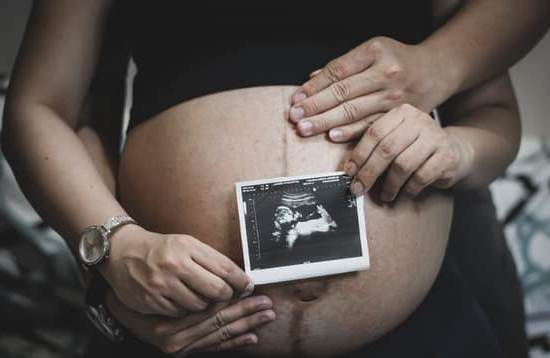How are pregnancy weeks calculated is a common question among expectant mothers, healthcare providers, and those curious about the intricacies of fetal development. Pregnancy weeks are a crucial way to track the progress of a pregnancy, monitor the growth of the fetus, and determine important milestones throughout the gestational period.
Understanding how pregnancy weeks are calculated involves various factors, including the starting point of conception, tools such as the pregnancy wheel used by healthcare providers, and different methods like ultrasound scans.
Conception marks the beginning of pregnancy, with gestation typically lasting around 40 weeks from this point onwards. Healthcare providers use tools like the pregnancy wheel to calculate pregnancy weeks accurately. This circular tool takes into account the first day of the last menstrual period (LMP) and helps estimate important dates such as due dates and trimester divisions. By understanding when conception occurred, healthcare professionals can provide more accurate information regarding fetal development and growth.
It is essential to differentiate between menstrual cycle weeks and gestational age when calculating pregnancy weeks. Menstrual cycle weeks are based on a woman’s menstrual cycle, while gestational age focuses on the actual time since conception.
Ultrasound scans play a vital role in measuring fetal growth and development throughout each trimester, helping to ascertain due dates and identify any potential issues that may arise during pregnancy. Overall, grasping how pregnancy weeks are calculated allows expectant mothers to better comprehend their journey through each stage of carrying a child.
Conception and Gestation
Pregnancy weeks are typically calculated from the first day of a woman’s last menstrual period (LMP). This method is used because it can be challenging to determine the exact date of conception, as it may vary depending on factors such as the length of a woman’s menstrual cycle.
By using the LMP as a starting point, healthcare providers can estimate when ovulation occurred and thus calculate an estimated due date for the baby. It is important to note that this method assumes a regular 28-day menstrual cycle, so adjustments may be made for women with irregular cycles.
- Understanding the concept of pregnancy weeks is crucial for expectant mothers to track their progress and ensure proper prenatal care throughout each trimester.
- Despite its slightly theoretical basis, calculating pregnancy weeks from the LMP provides a standardized way for healthcare providers to monitor fetal development and accurately estimate gestational age.
- In addition to the LMP, certain genetic testing or ultrasound scans can also provide more precise information about fetal growth and development to complement the estimated pregnancy weeks.
Moreover, gestation itself refers to the period of time between conception and birth. While pregnancies typically last around 40 weeks or 280 days, this timeframe can vary among individuals.
For instance, full-term pregnancies are considered to be between 37 and 42 weeks, and babies born before 37 weeks are classified as premature. Although gestational age can be approximated based on pregnancy weeks calculated from the LMP, other methods such as measuring fetal size through ultrasound scans also play a role in determining whether a baby is developing at an appropriate rate.
- It’s crucial for expectant mothers to understand how pregnancy weeks are calculated so they can actively participate in their prenatal care and make informed decisions about their health during each stage of pregnancy.
- By being aware of important dates like their estimated due date based on pregnancy week calculations, women can prepare themselves both mentally and physically for childbirth and parenthood.
- Pregnancy is a unique journey for every woman, so receiving personalized guidance from healthcare providers regarding how individual factors may influence pregnancy week calculations is essential for ensuring both maternal and fetal well-being.
The Pregnancy Wheel
What Is a Pregnancy Wheel?
A pregnancy wheel, also known as a gestation calculator or due date calculator, is a simple tool used by healthcare providers to estimate the duration of a pregnancy. It typically consists of a circular disc that can be rotated to match the mother’s last menstrual period (LMP) with the current date. This tool helps in determining important milestones such as the estimated due date and tracking the progress of the pregnancy week by week.
How Does the Pregnancy Wheel Work?
Healthcare providers use the first day of the woman’s last menstrual period as a starting point to calculate pregnancy weeks. By counting from this date, they can estimate how far along the mother is in her pregnancy. The pregnancy wheel takes into account the average length of a menstrual cycle (28 days) and considers ovulation occurring around day 14. By aligning these factors with the current date, healthcare providers can provide mothers with valuable information about their pregnancy progress.
The Importance of Accuracy
While the pregnancy wheel is a helpful tool for estimating pregnancy weeks, it is important to note that individual variations exist. Factors such as irregular menstrual cycles or late ovulation may impact the accuracy of these calculations.
In cases where the exact date of conception is known, healthcare providers may adjust their calculations accordingly. Overall, understanding how healthcare providers use the pregnancy wheel to calculate pregnancy weeks can help expectant mothers monitor their progress and prepare for their baby’s arrival.
Menstrual Cycle vs Gestational Age
When it comes to determining pregnancy weeks, understanding the difference between the menstrual cycle and gestational age is crucial. The menstrual cycle is typically around 28 days long, starting on the first day of a woman’s period and ending right before the next period begins.
On the other hand, gestational age is calculated from the date of conception, which usually occurs around two weeks after the start of the last menstrual period. This means that at conception, a woman is already considered two weeks pregnant.
Healthcare providers often use the gestational age as a more accurate way to track pregnancy progress. This is because calculating from conception provides a more clear timeline for fetal development. Due dates are typically estimated based on this gestational age, rather than solely relying on the menstrual cycle. However, it’s important to note that not all women have regular 28-day cycles, which can sometimes make pinpointing conception dates more challenging.
Ultrasound scans play a significant role in confirming gestational age and due dates during pregnancy. By measuring the size of the fetus and comparing it to standard growth charts, healthcare providers can accurately assess how far along a woman is in her pregnancy.
These scans also help identify any potential issues or abnormalities early on in the pregnancy journey. Overall, understanding these distinctions between menstrual cycle and gestational age can provide expectant mothers with a clearer picture of their pregnancy timeline and what to expect throughout each trimester.
Ultrasounds and Due Dates
Ultrasounds play a crucial role in prenatal care by providing healthcare providers with valuable information about the growth and development of the fetus. These imaging tests use high-frequency sound waves to create a visual representation of the baby inside the womb. One of the key aspects of ultrasounds is that they help determine the due date of the pregnancy. Healthcare professionals use measurements taken during ultrasound scans to estimate how far along a mother is in her pregnancy.
During an ultrasound scan, technicians measure the size of the fetus, particularly its head circumference, abdominal circumference, and femur length. Based on these measurements, healthcare providers can calculate an estimated due date for the expectant mother. This calculated due date is typically more accurate than using the date of the woman’s last menstrual period alone because it accounts for individual variations in menstrual cycles and ovulation.
It is important to note that ultrasounds done in early pregnancy (around 8-12 weeks) are considered more accurate for dating purposes than those conducted later on. This is because fetal growth is relatively consistent during this time frame, providing a reliable basis for estimating gestational age. However, even ultrasounds performed later in pregnancy can still offer valuable insights into the baby’s growth and overall health.
| Ultrasound Measurements | Role |
|---|---|
| Head circumference | Helps estimate fetal age and growth |
| Abdominal circumference | Aids in assessing fetal wellbeing and development |
| Femur length | Provides additional data for calculating gestational age accurately |
Trimesters
During pregnancy, the journey is typically divided into three distinct phases known as trimesters. Understanding these trimesters can help expectant mothers and healthcare providers track the progress of the pregnancy and monitor the growth and development of the baby. Each trimester brings its own set of changes and milestones, making it an exciting time for both parents-to-be.
First Trimester: Weeks 1-12
The first trimester is a crucial period in pregnancy as it involves significant developments in the fetus’s growth. This phase begins from the moment of conception until week 12, marking the early stages of pregnancy. During this time, many women experience common symptoms such as morning sickness, fatigue, and breast tenderness. Healthcare providers often use the first day of a woman’s last menstrual period to calculate this timeframe, even though conception typically occurs two weeks later.
Second Trimester: Weeks 13-26
The second trimester is often referred to as the “honeymoon phase” of pregnancy due to a decrease in early symptoms like nausea and an increase in energy levels. This period is characterized by rapid growth and development in the fetus, with vital organs forming and reaching viability outside the womb by week 24.
Many women also start to feel fetal movements during this trimester, contributing to their growing bond with their unborn child. Healthcare providers continue to monitor fetal growth through routine ultrasound scans during this phase.
Third Trimester: Weeks 27-Birth
The third trimester spans from week 27 until childbirth, marking the final stretch of pregnancy. During this phase, expectant mothers may experience physical discomfort due to the increased size of the baby and pressure on internal organs. It is essential for healthcare providers to closely monitor both mother and baby for any signs of complications or preterm labor. As the due date approaches, preparations for labor and delivery are made, ensuring a smooth transition into parenthood for both parents.
Understanding these three distinct phases of pregnancy can help expectant mothers feel more prepared and connected to their growing baby throughout each stage. By tracking the development milestones week by week within each trimester, healthcare providers can provide optimal care and support for both mother and child leading up to childbirth.
Development of the Fetus
During pregnancy, tracking the development of the fetus is an exciting and essential aspect for expectant mothers. Understanding how the baby grows week by week can provide valuable insights into their health and well-being. Healthcare providers use various methods to estimate the age of the fetus and monitor its progress throughout the pregnancy.
One common tool used by healthcare providers to track the growth of the fetus is through ultrasound scans. These scans can provide detailed images of the baby’s development, allowing healthcare professionals to measure key milestones such as fetal length, weight, and organ development. Ultrasound scans are also crucial in determining the due date of the baby, which plays a significant role in tracking the pregnancy weeks accurately.
To give a visual representation of this process, here is a breakdown of how healthcare providers calculate pregnancy weeks:
- Week 1: This marks the beginning of gestational age, calculated from the first day of your last menstrual period (LMP).
- Week 2: Fertilization typically occurs around this time when sperm meets egg.
- Week 3-40: The actual fetal development begins during this period, with distinct changes happening each week until childbirth.
Understanding these milestones and tracking them week by week can help both healthcare providers and expectant mothers ensure a healthy and successful pregnancy journey. By staying informed about these developments, expectant mothers can actively participate in monitoring their baby’s growth and prepare for childbirth.
Additional Factors
During pregnancy, there are several factors that can affect how healthcare providers calculate pregnancy weeks accurately. One important consideration is the mother’s menstrual cycle regularity. For women with irregular periods, it can be challenging to determine the exact date of conception and subsequent gestational age.
In such cases, healthcare providers may rely more on ultrasound measurements to estimate the due date and track fetal development. Additionally, conditions like polycystic ovary syndrome (PCOS) or hormonal imbalances can also impact the accuracy of pregnancy week calculations.
Another factor that may influence the calculation of pregnancy weeks is multiple pregnancies, such as twins or triplets. In these cases, healthcare providers adjust their calculations based on the number of fetuses present and their individual growth rates.
Multiple pregnancies often result in a shorter gestational period and earlier delivery than singleton pregnancies. Therefore, it is crucial for expectant mothers carrying multiples to receive specialized care and monitoring throughout their pregnancy to ensure the health and well-being of both mother and babies.
Moreover, certain medical conditions or procedures may impact how pregnancy weeks are calculated. For instance, women who undergo fertility treatments like in vitro fertilization (IVF) may have a known date of conception due to the assisted reproductive technology used.
This information allows healthcare providers to pinpoint a more accurate due date and track fetal growth accordingly. Similarly, women with preexisting medical conditions such as diabetes or high blood pressure require personalized care to manage their condition during pregnancy, which may affect the calculation of pregnancy weeks based on maternal and fetal health needs.
| Factors Affecting Pregnancy Week Calculations | Description |
|---|---|
| Menstrual Cycle Regularity | Irregular cycles can make it difficult to pinpoint conception date |
| Multiple Pregnancies | Adjustments are made for twins or triplets for accurate gestational age |
| Medical Conditions | Conditions like PCOS or IVF treatments can impact due date calculations |
Conclusion
In conclusion, understanding how pregnancy weeks are calculated is essential for expectant mothers to track the progress of their pregnancy accurately. The starting point of pregnancy is typically considered to be the first day of the last menstrual period, which may differ from the actual date of conception. Healthcare providers often use tools like the pregnancy wheel to calculate pregnancy weeks based on this information and provide due dates for expecting parents.
It’s important to differentiate between menstrual cycle age and gestational age when determining pregnancy weeks, as they can be two weeks apart. Ultrasound scans play a crucial role in measuring fetal growth and development, helping healthcare professionals adjust due dates if necessary. The trimesters of pregnancy further break down the journey into manageable phases, each with its own set of milestones and challenges for both mother and baby.
As expectant mothers progress through each week of their pregnancy, it is vital to consider additional factors that may affect the accuracy of calculating pregnancy weeks. Factors such as irregular menstrual cycles or underlying health conditions can influence gestational age calculations. By staying informed and working closely with healthcare providers, expectant mothers can better understand how pregnancy weeks are calculated and ensure a healthy and well-monitored prenatal journey for themselves and their babies.
Frequently Asked Questions
Is 4 Weeks Pregnant Actually 2 Weeks?
Being 4 weeks pregnant is actually the same as being 2 weeks past conception. This discrepancy is because pregnancy is calculated from the first day of your last menstrual period, not from conception itself.
How Do You Determine How Many Weeks Pregnant You Are?
Determining how many weeks pregnant you are involves counting from the first day of your last menstrual period to the current date. This method assumes a 28-day menstrual cycle and ovulation around day 14, leading to a standard calculation method for healthcare providers.
What Is the Exact Weeks of Pregnancy?
The exact week of pregnancy can be pinpointed by using ultrasound measurements during the first trimester. Ultrasound can accurately determine gestational age based on the size of the fetus and provide a more precise estimation of how far along in pregnancy someone is, especially if there are variations from a typical menstrual cycle or irregular ovulation patterns.

Welcome to my fertility blog. This is a space where I will be sharing my experiences as I navigate through the world of fertility treatments, as well as provide information and resources about fertility and pregnancy.





